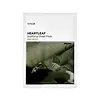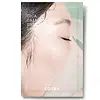What's inside
What's inside
 Key Ingredients
Key Ingredients

 Benefits
Benefits

 Concerns
Concerns

 Ingredients Side-by-side
Ingredients Side-by-side

Houttuynia Cordata Extract
Skin ConditioningGlycerin
HumectantWater
Skin ConditioningDipropylene Glycol
HumectantGlycereth-26
Humectant1,2-Hexanediol
Skin ConditioningArginine
MaskingCaprylyl Glycol
EmollientPropanediol
SolventIllicium Verum Fruit Extract
PerfumingAllantoin
Skin ConditioningSodium Hyaluronate
HumectantCentella Asiatica Extract
CleansingChamomilla Recutita Flower Extract
MaskingHippophae Rhamnoides Fruit Extract
Skin ConditioningHamamelis Virginiana Leaf Extract
Skin ConditioningCeramide NP
Skin ConditioningGlycosphingolipids
EmollientHydrogenated Lecithin
EmulsifyingCarbomer
Emulsion StabilisingXanthan Gum
EmulsifyingPolyglyceryl-4 Caprate
EmulsifyingEthylhexylglycerin
Skin ConditioningDisodium EDTA
Squalane
EmollientHouttuynia Cordata Extract, Glycerin, Water, Dipropylene Glycol, Glycereth-26, 1,2-Hexanediol, Arginine, Caprylyl Glycol, Propanediol, Illicium Verum Fruit Extract, Allantoin, Sodium Hyaluronate, Centella Asiatica Extract, Chamomilla Recutita Flower Extract, Hippophae Rhamnoides Fruit Extract, Hamamelis Virginiana Leaf Extract, Ceramide NP, Glycosphingolipids, Hydrogenated Lecithin, Carbomer, Xanthan Gum, Polyglyceryl-4 Caprate, Ethylhexylglycerin, Disodium EDTA, Squalane
Water
Skin ConditioningButylene Glycol
HumectantGlycerin
HumectantAlcohol
AntimicrobialBetaine
HumectantCentella Asiatica Extract
CleansingXanthan Gum
EmulsifyingPaeonia Suffruticosa Root Extract
Skin Protecting1,2-Hexanediol
Skin ConditioningPolyglyceryl-10 Laurate
Skin ConditioningChamomilla Recutita Flower Extract
MaskingGlyceryl Caprylate
EmollientPanthenol
Skin ConditioningEthylhexylglycerin
Skin ConditioningDisodium EDTA
Eucalyptus Globulus Leaf Oil
PerfumingCentella Asiatica Leaf Extract
Skin ConditioningMelaleuca Alternifolia Leaf Oil
AntioxidantHydrogenated Phosphatidylcholine
EmulsifyingDiethylhexyl Sodium Sulfosuccinate
CleansingCaprylic/Capric Triglyceride
MaskingSucrose Stearate
EmollientPantolactone
HumectantDipropylene Glycol
HumectantAsiaticoside
AntioxidantAsiatic Acid
Skin ConditioningMadecassic Acid
Skin ConditioningCholesterol
EmollientMadecassoside
AntioxidantCentella Asiatica Root Extract
Skin ConditioningWater, Butylene Glycol, Glycerin, Alcohol, Betaine, Centella Asiatica Extract, Xanthan Gum, Paeonia Suffruticosa Root Extract, 1,2-Hexanediol, Polyglyceryl-10 Laurate, Chamomilla Recutita Flower Extract, Glyceryl Caprylate, Panthenol, Ethylhexylglycerin, Disodium EDTA, Eucalyptus Globulus Leaf Oil, Centella Asiatica Leaf Extract, Melaleuca Alternifolia Leaf Oil, Hydrogenated Phosphatidylcholine, Diethylhexyl Sodium Sulfosuccinate, Caprylic/Capric Triglyceride, Sucrose Stearate, Pantolactone, Dipropylene Glycol, Asiaticoside, Asiatic Acid, Madecassic Acid, Cholesterol, Madecassoside, Centella Asiatica Root Extract
 Reviews
Reviews

Ingredients Explained
These ingredients are found in both products.
Ingredients higher up in an ingredient list are typically present in a larger amount.
1,2-Hexanediol is a synthetic liquid and another multi-functional powerhouse.
It is a:
- Humectant, drawing moisture into the skin
- Emollient, helping to soften skin
- Solvent, dispersing and stabilizing formulas
- Preservative booster, enhancing the antimicrobial activity of other preservatives
Centella Asiatica Extract (Centella) is derived from an herb native to Southeast Asia. It is famous for its anti-inflammatory and soothing properties.
Centella is rich in antioxidants and amino acids, such as Madecassic Acid and Asiaticoside.
Studies show the compounds in centella help with:
The combination of all these properties makes centella effective at soothing, hydrating, and protecting the skin.
Other great components of centella include Vitamin A, vitamin C, several B vitamins, and Asiatic Acid.
Fun fact: Centella has been used as a medicine and in food for many centuries. As a medicine, it is used to treat burns, scratches, and wounds.
Learn more about Centella Asiatica ExtractChamomilla Recutita Flower Extract comes from the Chamomile flower.
Chamomile is rich in antioxidants and has anti-inflammatory properties. Several compounds found in chamomile help with soothing, such as bisbolol.
Antioxidant components in chamomile make it an effective ingredient to help slow the signs of aging. Antioxidants help fight free-radical molecules, or molecules that may damage your skin.
Essential oils from chamomile have been found to improve wound healing due to its antimicrobial properties.
Ancient Greeks and Egyptians used Chamomile to treat skin redness and dryness. Chamomile has also been used to help treat stomach issues.
Learn more about Chamomilla Recutita Flower ExtractDipropylene Glycol is a synthetically created humectant, stabilizer, and solvent.
This ingredient helps:
Dipropylene glycol is technically an alcohol, but it belongs to the glycol family (often considered part of the ‘good’ alcohols). This means it is hydrating and gentle on skin unlike drying solvent alcohols like denatured alcohol.
As a masking agent, Dipropylene Glycol can be used to cover the smell of other ingredients. However, it does not have a scent.
Studies show Dipropylene Glycol is considered safe to use in skincare.
Learn more about Dipropylene GlycolDisodium EDTA plays a role in making products more stable by aiding other preservatives.
It is a chelating agent, meaning it neutralizes metal ions that may be found in a product.
Disodium EDTA is a salt of edetic acid and is found to be safe in cosmetic ingredients.
Learn more about Disodium EDTAEthylhexylglycerin (we can't pronounce this either) is commonly used as a preservative and skin softener. It is derived from glyceryl.
You might see Ethylhexylglycerin often paired with other preservatives such as phenoxyethanol. Ethylhexylglycerin has been found to increase the effectiveness of these other preservatives.
Glycerin is already naturally found in your skin. It helps moisturize and protect your skin.
A study from 2016 found glycerin to be more effective as a humectant than AHAs and hyaluronic acid.
As a humectant, it helps the skin stay hydrated by pulling moisture to your skin. The low molecular weight of glycerin allows it to pull moisture into the deeper layers of your skin.
Hydrated skin improves your skin barrier; Your skin barrier helps protect against irritants and bacteria.
Glycerin has also been found to have antimicrobial and antiviral properties. Due to these properties, glycerin is often used in wound and burn treatments.
In cosmetics, glycerin is usually derived from plants such as soybean or palm. However, it can also be sourced from animals, such as tallow or animal fat.
This ingredient is organic, colorless, odorless, and non-toxic.
Glycerin is the name for this ingredient in American English. British English uses Glycerol/Glycerine.
Learn more about GlycerinWater. It's the most common cosmetic ingredient of all. You'll usually see it at the top of ingredient lists, meaning that it makes up the largest part of the product.
So why is it so popular? Water most often acts as a solvent - this means that it helps dissolve other ingredients into the formulation.
You'll also recognize water as that liquid we all need to stay alive. If you see this, drink a glass of water. Stay hydrated!
Learn more about WaterXanthan gum is used as a stabilizer and thickener within cosmetic products. It helps give products a sticky, thick feeling - preventing them from being too runny.
On the technical side of things, xanthan gum is a polysaccharide - a combination consisting of multiple sugar molecules bonded together.
Xanthan gum is a pretty common and great ingredient. It is a natural, non-toxic, non-irritating ingredient that is also commonly used in food products.
Learn more about Xanthan Gum